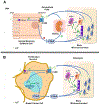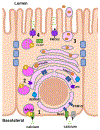Calcium Metabolism and Breast Cancer: Echoes of Lactation?
- PMID: 33299957
- PMCID: PMC7720883
- DOI: 10.1016/j.coemr.2020.11.006
Calcium Metabolism and Breast Cancer: Echoes of Lactation?
Abstract
Lactation requires a series of adaptations in maternal calcium and bone metabolism to ensure a steady supply of calcium to the lactating mammary gland. The alterations in systemic metabolism are accompanied by alterations in the expression of calcium receptors, channels, binding proteins, pumps and transporters in mammary epithelial cells to increase the uptake of calcium from the extracellular fluid and to transport it into milk. Intracellular calcium regulates signaling pathways that mediate changes in cell proliferation, differentiation and death and many of the molecules involved in supporting and coordinating calcium secretion into milk are re-expressed and redeployed to support malignant behavior in breast cancer cells. In this article, we review adaptations of systemic calcium homeostasis during lactation, as well as the mechanisms of milk calcium transport. We then discuss how reactivation of these pathways contributes to the pathophysiology of breast cancer.
Keywords: Bone; Breast Cancer; Calcium-sensing receptor; Lactation; Mammary gland; Parathyroid hormone-related protein.
Figures



Similar articles
-
Mammary-specific ablation of the calcium-sensing receptor during lactation alters maternal calcium metabolism, milk calcium transport, and neonatal calcium accrual.Endocrinology. 2013 Sep;154(9):3031-42. doi: 10.1210/en.2012-2195. Epub 2013 Jun 19. Endocrinology. 2013. PMID: 23782944 Free PMC article.
-
The calcium-sensing receptor regulates PTHrP production and calcium transport in the lactating mammary gland.Bone. 2006 Jun;38(6):787-93. doi: 10.1016/j.bone.2005.11.009. Epub 2005 Dec 27. Bone. 2006. PMID: 16377269
-
Calcium-Sensing Receptor in Breast Physiology and Cancer.Front Physiol. 2016 Sep 30;7:440. doi: 10.3389/fphys.2016.00440. eCollection 2016. Front Physiol. 2016. PMID: 27746743 Free PMC article. Review.
-
TRIENNIAL LACTATION SYMPOSIUM/BOLFA: Serotonin and the regulation of calcium transport in dairy cows.J Anim Sci. 2017 Dec;95(12):5711-5719. doi: 10.2527/jas2017.1673. J Anim Sci. 2017. PMID: 29293773 Free PMC article. Review.
-
The calcium-sensing receptor regulates mammary gland parathyroid hormone-related protein production and calcium transport.J Clin Invest. 2004 Feb;113(4):598-608. doi: 10.1172/JCI18776. J Clin Invest. 2004. PMID: 14966569 Free PMC article.
Cited by
-
PTHrP induces STAT5 activation, secretory differentiation and accelerates mammary tumor development.Breast Cancer Res. 2022 Apr 19;24(1):30. doi: 10.1186/s13058-022-01523-1. Breast Cancer Res. 2022. PMID: 35440032 Free PMC article.
-
Epigallocatechin 3-gallate inhibits the plasma membrane Ca2+-ATPase: effects on calcium homeostasis.Heliyon. 2021 Feb 26;7(2):e06337. doi: 10.1016/j.heliyon.2021.e06337. eCollection 2021 Feb. Heliyon. 2021. PMID: 33681501 Free PMC article.
-
Impact of Fluoxetine Treatment and Folic Acid Supplementation on the Mammary Gland Transcriptome During Peak Lactation.Front Pharmacol. 2022 Feb 23;13:828735. doi: 10.3389/fphar.2022.828735. eCollection 2022. Front Pharmacol. 2022. PMID: 35281892 Free PMC article.
-
Exploration of the lactation function of protein phosphorylation sites in goat mammary tissues by phosphoproteome analysis.BMC Genomics. 2021 Sep 28;22(1):703. doi: 10.1186/s12864-021-07993-5. BMC Genomics. 2021. PMID: 34583635 Free PMC article.
-
The Serotonergic System and Bone Metabolism During Pregnancy and Lactation and the Implications of SSRI Use on the Maternal-Offspring Dyad.J Mammary Gland Biol Neoplasia. 2023 Apr 22;28(1):7. doi: 10.1007/s10911-023-09535-z. J Mammary Gland Biol Neoplasia. 2023. PMID: 37086330 Free PMC article. Review.
References
-
- Sadovnikova A, Wysolmerski John J, Hovey Russell C. The onset and maintenance of human lactation and its endocrine regulation. In: Kovacs C, Deal C, eds. 1st Edition ed: Academic Press; 2019:189–200.
-
- Bray F, Ferlay J, Soerjomataram I, Siegel RL, Torre LA, Jemal A. Global cancer statistics 2018: GLOBOCAN estimates of incidence and mortality worldwide for 36 cancers in 185 countries. CA: A Cancer Journal for Clinicians. 2018;68(6):394–424. - PubMed
-
- Kovacs CS. Maternal mineral and bone metabolism during pregnancy, lactation, and post-weaning recovery. Physiological Reviews. 2016;96(2):449–547. - PubMed
-
This is an extensive review of the maternal adaptations in mineral and bone physiology during pregnancy, lactation and post-weaning recovery
-
- Ross AC, Manson JAE, Abrams SA, Aloia JF, Brannon PM, Clinton SK, Durazo-Arvizu RA, Gallagher JC, Gallo RL, Jones G, Kovacs CS, Mayne ST, Rosen CJ, Shapses SA. The 2011 report on dietary reference intakes for calcium and vitamin D from the Institute of Medicine: What clinicians need to know. Vol 96: Endocrine Society; 2011:53–58. - PMC - PubMed
-
- Torres DA, Freitas MB, Gonçalves RV. Changes in bone turnover and calcium homeostasis during pregnancy and lactation in mammals: a meta-analysis. Reproduction, Fertility and Development. 2018;30(5):681–681. - PubMed
Grants and funding
LinkOut - more resources
Full Text Sources
Research Materials
